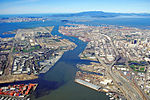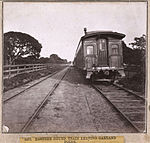Alameda Mole
1878 establishments in CaliforniaBuildings and structures in Alameda, CaliforniaDemolished railway stations in the United StatesFerry terminals in the San Francisco Bay AreaFormer railway stations in California ... and 4 more
Piers in CaliforniaRailway stations in Alameda County, CaliforniaRailway stations in the United States opened in 1878Transportation buildings and structures in Alameda County, California

The Alameda Mole was a transit and transportation facility in Alameda, California for ferries landing in the East Bay of San Francisco from 1878 to the 1930s. It was located on the west end of Alameda, and later became part of the Alameda Naval Air Station. It was one of four neighbouring moles. The others were the Oakland Mole, the WP Mole (Western Pacific), and the Key System Mole. The purpose of the mole was to extend tracks of rail-based transportation lines beyond the shallow mud flats along the shore of the East Bay into water deep enough to accommodate the passenger and rail ferries to San Francisco.
Excerpt from the Wikipedia article Alameda Mole (License: CC BY-SA 3.0, Authors, Images).Alameda Mole
Airfield Perimeter Road,
Geographical coordinates (GPS) Address Nearby Places Show on map
Geographical coordinates (GPS)
| Latitude | Longitude |
|---|---|
| N 37.796 ° | E -122.329 ° |
Address
Airfield Perimeter Road
Airfield Perimeter Road
94110
California, United States
Open on Google Maps








